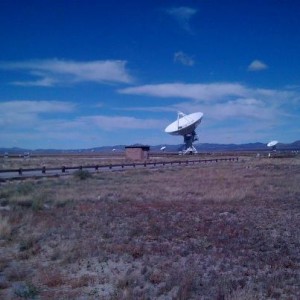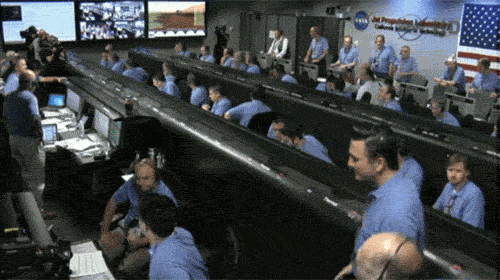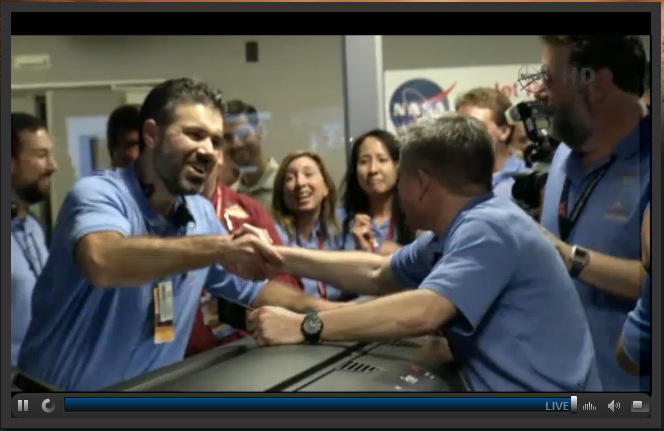Mixing NASA and Leonard Nimoy is always a recipe for success. Adding ion propulsion engines just makes it that much cooler. (via)
Category Archives: Space
A Geek’s Guide to New Mexico
As some of you may know, Shane (my other half and sometimes blogger for Tosche Station) has been working out in New Mexico for the last few months, and since fall break was this week, I traveled out to see him, and we took the opportunity to investigate some of the geeky offerings that New Mexico has to offer, and I have been dispatched to share them with you.
We stayed mostly in the Albuquerque area, but the first thing we did was visit the Very Large Array, the world’s largest radio telescope.  It’s recently been upgraded into the Expanded Very Large Array (they’re really sticking with the imaginative names here), in order to revamp and bring the technology up to state of the art. Made up of 27 giant antennas that can be moved around three 21 mile long tracks, the VLA also serves as the control center and part of the Very Large Baseline Array, an array of telescopes that connects radio telescopes from Hawaii to the Caribbean to create one giant, continental radio telescope. You can tour the VLA most days if you’re in the area, but if you don’t find yourself in New Mexico, you can take a virtual tour via the National Radio Astronomy Observatory’s website. If you do go in person, know that once you get outside of Socorro, you should go ahead and turn off your cell phone; you’ll drain your battery as it searches for a signal, and when you get to the VLA, you have to turn off your cell phone and any other devices that might transmit radio signals, as they can interfere with observations (though turning your cell phone to airplane mode will allow you to be able to take pictures at the site).
It’s recently been upgraded into the Expanded Very Large Array (they’re really sticking with the imaginative names here), in order to revamp and bring the technology up to state of the art. Made up of 27 giant antennas that can be moved around three 21 mile long tracks, the VLA also serves as the control center and part of the Very Large Baseline Array, an array of telescopes that connects radio telescopes from Hawaii to the Caribbean to create one giant, continental radio telescope. You can tour the VLA most days if you’re in the area, but if you don’t find yourself in New Mexico, you can take a virtual tour via the National Radio Astronomy Observatory’s website. If you do go in person, know that once you get outside of Socorro, you should go ahead and turn off your cell phone; you’ll drain your battery as it searches for a signal, and when you get to the VLA, you have to turn off your cell phone and any other devices that might transmit radio signals, as they can interfere with observations (though turning your cell phone to airplane mode will allow you to be able to take pictures at the site).
For more geeky adventures, click to the jump. Continue reading
International Space Station Captures Dragon Capsule

Early this morning, the crew of the International Space Station reached out with its robotic arm and captured SpaceX’s Dragon module. The capture and eventual docking marks the first privately driven cargo delivery to the space station, something that could change the landscape of manned spaceflight.
The ramifications are potentially huge. If SpaceX can make these deliveries reliably, it frees NASA’s budget and brainpower to focus on other projects. Perhaps a high-capacity launch vehicle to send something like the Orion capsule beyond Low Earth Orbit? Of course, SpaceX still has some hurdles to clear in order to become that reliable. First and foremost, it’s got to figure out why one of its Falcon 9 engines failed during Sunday’s launch. Still, this is huge for SpaceX and for NASA. Further progress can get NASA out of the cargo and crew shuttling business and into more Final Frontier kind of exploration.
Neil Armstrong Dies at 82
Neil Armstrong, commander of Apollo 11 and the first man to set foot on the moon, passed away yesterday at 82.
“As long as there are history books, Neil Armstrong will be included in them,” said Charles Bolden. “As we enter this next era of space exploration, we do so standing on the shoulders of Neil Armstrong. We mourn the passing of a friend, fellow astronaut and true American hero.”
Touchdown! Curiosity is Wheels Down on Mars!

There’s a few dozen celebrating mission control members at JPL right now as Curiosity, the newest and biggest rover from NASA, has safely gone wheels-down on Mars. The absolutely crazy, insane landing procedure looked like something out of a Michael Bay film, but the engineers at JPL and NASA have pulled it off.
Curiosity is the most advance rover to set wheels on Mars. It’s intricate and complex science equipment will hopefully be able to give us a glimpse as to the history of water on the Red Planet and whether or not it was ever capable of supporting life and, more importantly, whether life has ever been there. Here’s one of Curiosity’s first images from Gale Crater.

To celebrate the occasion, Curiosity quoted the philosopher Wheaton
I’m safely on the surface of Mars. GALE CRATER I AM IN YOU!!!
#MSL— Curiosity Rover (@MarsCuriosity) August 6, 2012
Space. It’s frakking awesome.
Rest in Peace, Dr. Sally Ride

When I was a little girl, I wanted to be an astronaut. Not long after moving to Florida, I became fascinated with space exploration and decided that was my future career, no questions asked. To seven-year-old me, it didn’t matter that I got motion sickness or that space travel was dangerous (the Challenger had just exploded two years prior, and I endured many questions of “doesn’t that scare you?” from classmates). All I knew was that I wanted to fly to the stars.
Nobody said to me, however, that I couldn’t be an astronaut. And when I went to Space Camp (four times, mind you), I wasn’t the only girl on my team: there were always a handful of others. Dr. Sally Kristen Ride is part of the reason for that.
Ride became an astronaut in 1978, the first class to include women. (The others were Anna Fisher, Shannon Lucid, Judy Resnik, Rhea Seddon, and Kathryn Sullivan.) She earned four degrees from Stanford University, including a doctorate in physics in 1978. Needless to say, she was quite qualified for her position as a mission specialist, and was the lucky woman chosen to be the first American woman in space. Her first flight was aboard STS-7, Challenger, in 1983. She also flew on another shuttle mission, STS-41G, in 1984.
I could go on and list all of Ride’s numerous awards and accomplishments, but that’s not what’s really important. What’s important is the inspiration Sally Ride gave to numerous girls and young women over the years. I never once thought “I can’t be an astronaut,” because women like her were brave enough to trailblaze new fields when they were being told they couldn’t. She continued to be an inspiration even after leaving the astronaut corps, founding Sally Ride Science, where she helped to encourage girls to pursue careers in science and mathematics. I know how important that is: I did my master’s thesis on female workers at Kennedy Space Center, and as part of my research I interviewed many female engineers who were told they couldn’t study science because that was a “man’s” subject.
I didn’t become an astronaut, obviously – I eventually realized that the motion sickness, and my lack of ability in science and math would be a hindrance to that career – but my interest in space exploration never waned. During graduate school I worked in the Kennedy Space Center Visitor Complex education department, and it was the funnest job I’ve ever had. I loved teaching little kids about space and hoping that they, like me, would be inspired by their time at KSC. And even though I never flew into space myself, I thank that ambition for my lifelong interest in science fiction.
To say I was saddened to hear the news of Sally Ride’s passing is an understatement. Not only was she an accomplished individual who inspired a generation of young girls – and boys – but 61 is far too young to die. I never got the chance to meet her or listen to her speak in person, but I will always be grateful for her contributions to science. Even more so, I thank her for the fact that she didn’t listen whenever someone said “girls can’t do that.”
Thank you, Dr. Sally Ride, and rest in peace.
A Giant Leap For Mankind 43 Years Ago Today
I always get chills when watching this video. It may not have been readily apparent to those watching at the time, but Apollo 11 nearly had to abort the landing attempt on three occasions. The first two were caused by program alarms when the computer’s processor became overloaded. The third happened as the navigation system directed the lander towards a boulder-filled crater, forcing commander Neil Armstrong to prolong the landing attempt and find a safe landing zone. When you hear “sixty seconds,” it’s CAPCOM Charlie Duke alerting the entire world that if they don’t touch down in a minute, the abort sequence will initialize.
But they landed, thanks to the teamwork at mission control, the watchful eye of Michael Collins, the guidance of Buzz Aldrin, and the cool of Neil Armstrong. On July 20, 1969 with seventeen seconds of fuel remaining, humankind set foot on the Moon.
International Space Station Catches A Dragon By The Tail
And we’ve got a little bit of space history made today.
The Dragon Module, a crew and cargo capsule designed by Elon Musk’s SpaceX program, has just docked with the International Space Station. This is the first docking the multinational station and a private space vehicle, marking a huge step forward for low-Earth orbit space travel.
Falcon 9 and Dragon Module Lift Off
At 3:44 AM EDT Elon Musk and SpaceX’s Falcon 9 finally blasted off the launchpad today and began what may be a new era in spaceflight. For the SpaceX team, it had been a long and bumpy road to get to this point. Several setbacks pushed the launch date deep into May. At the last possible moment on a launch attempt last Saturday morning, the sequence was aborted when a pressure discrepancy was spotted by the computer in the number five Merlin 1C engine.
Today, however, things went off without a hitch.
After the launch and separation, NASA and the SpaceX crew watched as the Dragon supply and crew module successfully separated from the Falcon 9 rocket and deployed its solar array, another enormous milestone for the program.
Today kicks off a roughly two-week mission for the Dragon module that, if all goes well, will lead to the first docking between the International Space Station and a private space vessel. In the macro view, a successful Falcon 9 and Dragon program means that NASA has a much more affordable crew and cargo transport vehicle that frees them from dependency on the Russian Soyuz. Success could even mean that NASA has the freedom to work on something even greater, perhaps a heavy launch vehicle that can deliver crew and cargo beyond low Earth orbit.
Falcon 9 Launch Scrubbed, Rescheduled for Tomorrow
Saturday’s attempted launch of SpaceX’s Falcon 9 launch vehicle and Dragon capsule looked like it was going to go off without a hitch. Until one second remained in the countdown.
Launch aborted: slightly high combustion chamber pressure on engine 5. Will adjust limits for countdown in a few days.
— Elon Musk (@elonmusk) May 19, 2012
Engineers have spent the last few days looking over the number five Merlin 1C engine and have determined the Falcon 9 can be cleared for another launch attempt tomorrow morning, only a few days after the latest scrub.
With any luck, at 3:44AM EDT the mission can resume and we’ll find out if we’re one big step closer towards a new crew transport vehicle.

